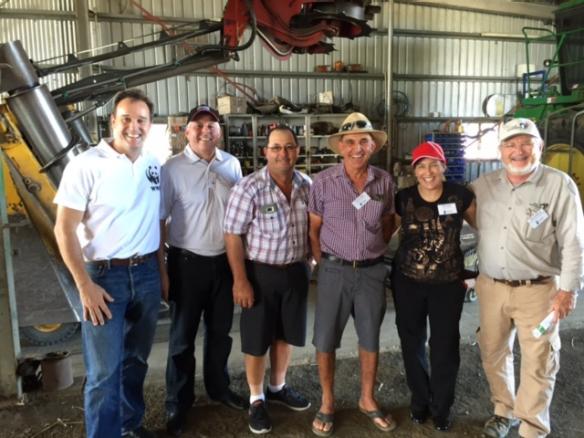
Growing Strong
Aussie canegrowers showcase water conservation project
23-11-2015
-
North Queensland canegrowers rolled out the wet carpet this week, playing host to The Coca-Cola Company’s chief sustainability officer, Bea Perez.
-
A global advocate of sustainable communities, Bea met the local farmers driving Project Catalyst, a $14 million joint initiative with co-funding from the government to protect Australia’s most famous waterway, the Great Barrier Reef.
-
The project is also helping Coca-Cola reach its global 2020 water replenishment goal, a commitment to returning 100 percent of the water used by the Coca-Cola system through wastewater treatment and replenishment projects.
-
“It’s wonderful to see so many dedicated sugarcane growers band together to make a difference,” Bea says.
-
“Part of meeting our replenishment goal is engaging in diverse, locally focused community water projects, which work towards set objectives such as supporting water conservation and raising awareness on critical local water issues.”

Roberto Mercade, President of Coca‑Cola South Pacific is proud of the success behind Project Catalyst and the example it serves to the global community.
“Project Catalyst is a model for working together that we hope to replicate in other places and with other commodities,” Roberto says, “what we are learning here with Project Catalyst can have an impact not only for Australia, but around the world.”
During the two-day tour of the region, farmers in Mackay and Proserpine shared their innovative farming practices with Perez, which aim to reduce the impact of their farming on the Great Barrier Reef.
“Here in Australia we are working with sugar growers and local partners to reduce agricultural runoff to the Great Barrier Reef by more than 180 tonnes each year. Together we’re working to ensure that any water that does run off their farms is of the highest quality, by improving soil, nutrient, pesticide, irrigation and storm water management on over 20,000 hectares of farm land,” Bea said.

TCCC’s Chief Sustainability Officer, Bea Perez got up close and personal with Australian wildlife on her visit to North Queensland.
Planning for the future
A program that has helped improve the quality of more than 100 billion litres of water flowing into the Great Barrier Reef, Project Catalyst has undeniably contributed to the achievement of Coca‑Cola’s 2020 goal to replenish 100 percent of the water it uses in its products, which could be achieved by as early as the end of this year.
“Water is a shared resource essential to our business and communities we serve,” said Bea.
“Project Catalyst is one of the many water projects and partnerships supported globally by Coca‑Cola, and we are proud of their leadership and achievements made in sustainable agriculture and watershed protection.”

Working together
Coca‑Cola has provided $3.25 million over the past six years to the $14m joint initiative with co-funding from the federal government, the World Wildlife Fund (WWF) and local not-for-profit resource management group Reef Catchment.
WWF CEO, Dermot O’Gorman said, “Best practices such as those trialled by Project Catalyst, if widely adopted, will deliver a more efficient, profitable and sustainable cane industry; WWF will continue its support for the industry to make this transition.”
Reef Catchments Manager, Katrina Dent agrees, “Project Catalyst growers, who are championing this sustainable initiative, are paving the way for change, thinking outside the box and taking action, which not only generates environmental outcomes, but also increases business profitability.”
“Water is a shared resource essential to our business and communities we serve. Project Catalyst is just one of the many water projects and partnerships supported globally by Coca‑Cola, and we are proud of their leadership and achievements made thus far in sustainable agriculture and watershed protection,” said Bea.
“We aim to ensure programs like these remain sustainable within communities over time and continue to replenish water.”
Read Time
What others are reading
More to enjoy
